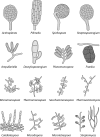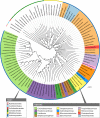Taxonomy, Physiology, and Natural Products of Actinobacteria
- PMID: 26609051
- PMCID: PMC4711186
- DOI: 10.1128/MMBR.00019-15
Taxonomy, Physiology, and Natural Products of Actinobacteria
Erratum in
-
Correction for Barka et al., Taxonomy, Physiology, and Natural Products of Actinobacteria.Microbiol Mol Biol Rev. 2016 Nov 9;80(4):iii. doi: 10.1128/MMBR.00044-16. Print 2016 Dec. Microbiol Mol Biol Rev. 2016. PMID: 28575842 Free PMC article. No abstract available.
Abstract
Actinobacteria are Gram-positive bacteria with high G+C DNA content that constitute one of the largest bacterial phyla, and they are ubiquitously distributed in both aquatic and terrestrial ecosystems. Many Actinobacteria have a mycelial lifestyle and undergo complex morphological differentiation. They also have an extensive secondary metabolism and produce about two-thirds of all naturally derived antibiotics in current clinical use, as well as many anticancer, anthelmintic, and antifungal compounds. Consequently, these bacteria are of major importance for biotechnology, medicine, and agriculture. Actinobacteria play diverse roles in their associations with various higher organisms, since their members have adopted different lifestyles, and the phylum includes pathogens (notably, species of Corynebacterium, Mycobacterium, Nocardia, Propionibacterium, and Tropheryma), soil inhabitants (e.g., Micromonospora and Streptomyces species), plant commensals (e.g., Frankia spp.), and gastrointestinal commensals (Bifidobacterium spp.). Actinobacteria also play an important role as symbionts and as pathogens in plant-associated microbial communities. This review presents an update on the biology of this important bacterial phylum.
Copyright © 2015, American Society for Microbiology. All Rights Reserved.
Figures









References
-
- Ludwig W, Euzéby J, Schumann P, Buss HJ, Trujillo ME, Kämpfer P, Whiteman WB. 2012. Road map of the phylum Actinobacteria, p 1–28. In Goodfellow M, Kämpfer P, Busse HJ, Trujillo ME, Suzuki KI, Ludwig W, Whitman WB (ed), Bergey's manual of systematic bacteriology, vol 5 Springer-Verlag, New York, NY.
-
- Macagnan D, Romeiro RDS, de Souza JT, Pomella AWV. 2006. Isolation of actinomycetes and endospore-forming bacteria from the cacao pod surface and their antagonistic activity against the witches' broom and black pod pathogens. Phytoparasitica 3:122–132. doi:10.1007/BF02981312. - DOI
-
- Lechevalier HA, Lechevalier MP. 1965. Classification des actinomycètes aérobies basée sur leur morphologie et leur composition chimique. Ann Inst Pasteur 108:662–673. (In French.) - PubMed
-
- Zimmerman W. 1980. Degradation of lignin by bacteria. J Biotechnol 13:199–130.
Publication types
MeSH terms
Substances
LinkOut - more resources
Full Text Sources
Other Literature Sources
Miscellaneous

